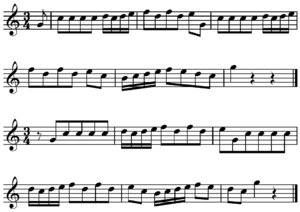
Back Frasering Danish Phrasierung German Frazigo Esperanto Fraseerimine Estonian Fraseeraus Finnish Phrasé French Фразировка Kirghiz Frasering Dutch Frazowanie Polish Фразировка Russian


Musical phrasing is the method by which a musician shapes a sequence of notes in a passage of music to allow expression, much like when speaking English a phrase may be written identically but may be spoken differently, and is named for the interpretation of small units of time known as phrases (half of a period). A musician accomplishes this by interpreting the music—from memory or sheet music—by altering tone, tempo, dynamics, articulation, inflection, and other characteristics. Phrasing can emphasise a concept in the music or a message in the lyrics, or it can digress from the composer's intention, aspects of which are commonly indicated in musical notation called phrase marks or phrase markings. For example, accelerating the tempo or prolonging a note may add tension.
A phrase is a substantial musical thought, which ends with a musical punctuation called a cadence. Phrases are created in music through an interaction of melody, harmony, and rhythm.[3]
Giuseppe Cambini—a composer, violinist, and music teacher of the Classical period—had this to say about bowed string instruments, specifically violin, phrasing:
The bow can express the affections of the soul: but besides there being no signs that indicate them, such signs, even were one to invent them, would become so numerous that the music, already too full of indications, would become a formless mass to the eyes, almost impossible to decipher. I should consider myself fortunate if I could only get a student to hear, through a small number of examples, the difference between bad and mediocre, mediocre and good, and good and excellent, in the diversity of expressions that one may give to the same passage.[4]
— "Nouvelle Méthode théorique et pratique pour le violon". Paris, Naderman (c. 1803)
- ^ Newman, William S. (1995). Beethoven on Beethoven: Playing His Piano Music His Way, p.170-71. ISBN 0-393-30719-0.
- ^ White, John D. (1976). The Analysis of Music, p. 44. ISBN 0-13-033233-X.
- ^ Benward, Bruce & Saker, Marilyn (2003). Music: In Theory and Practice, Vol. I, p.89. Seventh Edition. McGraw-Hill. ISBN 978-0-07-294262-0.
- ^ "Nouvelle Méthode théorique et pratique pour le violon" by Giuseppe Cambini (ref)
© MMXXIII Rich X Search. We shall prevail. All rights reserved. Rich X Search